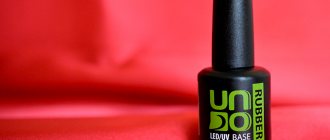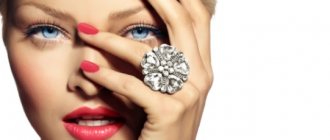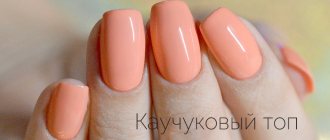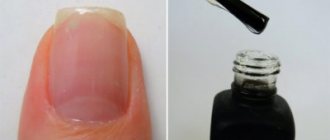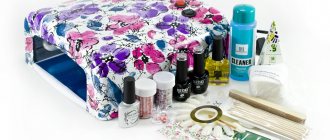I often get asked, what is the best base for gel polish? So that it stands on the nails for three months, it evens out the nail plate itself, does not cause detachments, and does not harm the nails.
I have some experience that I gained while working with some databases and now I’m ready to share it.
Here's what I'll tell you about:
- Why do you need a base?
- Differences between liquid and thick bases
- How to choose a base for different types of nails
- How to apply base correctly
- Is it possible to apply top instead of base?
- Errors when working with the database. What not to do when applying base
- Is it possible to strengthen and extend the nail plate with a base?
- Is it possible to cover nails with gel polish without a base?
- Expensive and cheap base - what are the differences?
- My rating of bases for gel polishes, and what are my plans for the future
So:
Why do you need a base?
It is the base that holds the gel polish on the nails. It acts as a layer between the natural nail and the polymer coating.
The base is in direct contact with the nail. Not gel polish, but a base. Therefore, it is very important to choose a base that will hold the gel polish firmly on the nails, but will not harm the nails.
The base coating is designed to protect the nail plate from coloring pigments in gel polishes, smooth out all defects on the surface of the nails, and ensure reliable adhesive bonding of the polymer material to the nail.
Another important function of the base is to strengthen the nail plate. The natural nail may be weak, thin, or bend and break. All this will not allow the coating to last on the nails for the required 2-3 weeks. A properly selected base will strengthen and protect even the thinnest and weakest nails.
Detachments, chips, cracks - all this can happen due to a poorly selected base.
By color
View this post on Instagram
Publication from FORMULA PROFI | GEL POLISH (@formula_profi_russia)
There are two types of base color:
- Transparent, colorless;
- Camouflage.
Transparent bases do not contain any pigment and are applied to the nail plate in an inconspicuous layer. Colorless bases are suitable for coating in any color, with any design.
Camouflage bases have color and, in addition to the main functions of base coats, they additionally mask nail imperfections. Also, camouflage bases can replace two layers at once - base and color. Camouflage bases have an internal classification:
- Classic camouflages. This is a base coat in a natural shade - peach, milky, pink. Such bases are often used for nude manicure, as well as for the popular French manicure;
- Colored bases. This is a new generation of camouflages with the same characteristics, but a wider palette of colors. There are pastel, muted and neon shades.
Health hazards of gel polish and its components
Differences between liquid and thick bases
Liquid bases are highly durable. They practically do not shrink on long nails. Suitable for craftsmen with experience, because... Due to its liquid consistency, the nail plate must be leveled quickly, otherwise streaks cannot be avoided.
I remember how freaked out I was when I just started working, and not yet understanding the intricacies of choosing a base. I bought something cheap, very liquid and smelly. Later, I learned to work with liquid bases, and realized that they are not suitable for all types of nails. A strong smell is a sign of a not very good base.
Liquid base is good for strong, healthy nails. With a pronounced apex. On bendable, soft nails, the base can cause detachments and chips.
And yes, you cannot extend your nails with a liquid base.
Thick bases - they are also called Rubber (which is translated from English - eraser, i.e. these bases are elastic), and not rubber, as many masters like to call them. Due to their thickness, they are easy to work with and the leveling is perfect. Also, with the help of a thick base, you can extend your nail without any problems. Great for weak, easily bending nails. The only disadvantage of this base is that it shrinks on long nails, and the longer the nail, the more it sinks. This feature must be taken into account.
After the second week of wear, the coating begins to sag, and the architecture of the nail is disrupted.
Rating of the top 10 best nail bases according to KP
ARTEX base coat Make-up Corrector Rubber
ARTEX Photo: ARTEX
Make-up Corrector Rubber from ARTEX is ideal for strengthening and smoothing the nail plate, filling all cracks and irregularities. The base is suitable for working with thin, brittle, short nails under gel polish or gel paint. Many masters use it to create nail architecture and to increase length.
The base coat of Make-up Corrector Rubber does not chip or peel, is easy to apply and level, and does not bake in the lamp. Due to the perfect camouflage nude shades, it does not require an additional color layer and is not noticeable as the nail grows. When removing the coating, it does not require preliminary washing of the surface and is easily removed with liquid within 5-10 minutes, so it is suitable for express manicure. The base coat is available in two volumes - 15 and 50 ml.
Advantages and disadvantages
suitable for brittle and problematic nails, invisible when growing, easy to remove
incompatible with other gel polishes
show more
Cosmoprofi Base Coat

Cosmoprofi Photo: Cosmoprofi
Cosmoprofi rubber transparent nail base eliminates all unevenness of the nail plate and creates a smooth and durable base for applying gel polish. Despite its fairly liquid consistency, the base is easy to apply and level, creates a medium-hard frame without excess volume, and protects nails from yellowing, delamination and coloring pigments. The base is mainly used on strong, undeformed nails; it does not burn when polymerized in a lamp. Polymerization in an LED lamp takes only a minute, in a UV lamp - 2 minutes. The base does not chip or crack for at least 3 weeks.
Advantages and disadvantages
does not bake in the lamp, self-levels, prevents splitting and yellowing of nails
not suitable for problematic or weakened nails
show more
KLIO Professional Rubber Base Extra

KLIO Photo: KLIO
The extra-thick rubber base Rubber Base Extra from KLIO Professional is ideal for problematic nails - thin, flaky, prone to brittleness. Despite the thick consistency, the base is easy to apply, it does not flow and evens out perfectly, while the nail plate looks natural, without excess volume. At the same time, the consumption of the product itself is minimal.
Rubber Base Extra is great for repairing, extending and leveling the nail plate, as well as for attaching rhinestones - even large ones. Separately, it is worth noting the comfortable brush - short, flat with evenly trimmed dense bristles.
Advantages and disadvantages
Levels well, strengthens nails, economical consumption, does not leak
bakes in a lamp, especially if applied in several layers to level the nail plate
show more
Lianail Factor Base

Lianail Photo: Lianail
The instant base for a thin coating from the Latvian brand Lianail has a fairly liquid consistency, making it easy to apply, but does not spread or weigh down the nail plate, and also levels out perfectly. There is also a base option with a thicker consistency. Suitable as a base for gel, acrylic and acrylic.
The thin coating is suitable for nails that do not require leveling. But the thick rubber base is suitable for both leveling and building up. The black matte bottle with the product itself looks very stylish and expensive, but gets dirty easily. The brush has a standard shape, the bristles are soft, the hairs are cut evenly, and it paints well near the cuticle and side ridges.
Advantages and disadvantages
comfortable brush, does not spread and does not weigh down the nail plate
small volume (only 10 ml)
show more
Imen base coat Rubber base
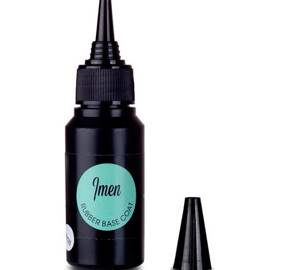
Rubber base Photo: Rubber base
The Rubber base from the famous Russian brand Imen has a medium (closer to thick) consistency, which allows even beginners to easily and evenly distribute the coating over the nail plate, without drips or staining of the cuticle and side ridges. The base is self-leveling, suitable for all types of nails, including thin and weakened ones. The polymerization time in an LED lamp is at least 30 seconds, in a UV lamp - 60 seconds (professionals recommend using a combined LED/UV lamp).
The durability of the coating with the base is excellent - at least 2-3 weeks without chipping, does not conflict with color coatings of other brands, and can also be easily removed with liquid (after cutting off the top layer).
Advantages and disadvantages
does not conflict with color coatings of other brands, easy and economical to apply, durability 3 weeks
may sag on long nails
show more
Luxio gel Base Natural

Luxio Photo: Luxio
Luxio gel Base Natural Camouflage Base is a classic base coat from the Canadian brand Luxio. The manufacturer describes the base as “a 100% gel that provides a durable, long-lasting, beautiful coating, protects the nail from external damage and gives a bright glossy shine.” The base has a fairly liquid consistency, is easy to apply and spread, does not have a strong chemical odor, does not cause allergic reactions, and is easily and quickly removed with liquid (Akzentz Soak Off). Separately, it is worth noting the original and very comfortable brush - narrow, short, tightly packed, with a perfect cut. This brush easily applies the material even under the cuticle and paints all corners well, without streaking. The durability of the coating with Luxio gel Base Natural is about 2-3 weeks, without chipping or peeling, and you can only count on light leveling, but building up and building the nail architecture is excluded.
Advantages and disadvantages
comfortable brush, easy to apply without smudges, lasts at least 2-3 weeks without chipping or peeling
high price, not suitable for extensions, sag on long nails
show more
Vogue Nails base coat Rubber
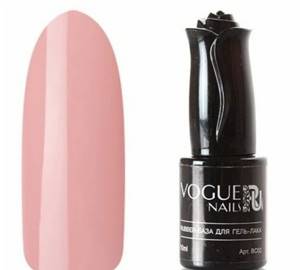
Vogue Nails Photo: Vogue Nails
Rubber base coat from the Russian brand Vogue Nails is a thick, elastic rubber base suitable for strengthening thin, soft and weakened nails, as well as for smoothing the nail plate. The line includes 12 nude translucent shades from soft pink to peach, and therefore the base can be used simultaneously as a color coating, suitable for a French jacket. Any gel polish also fits perfectly on it, does not spread, does not form bubbles and does not shrink. The coating is durable and resistant - no peeling, chipping or scratching for at least 2-3 weeks. The base is polymerized in both UV and LED lamps. The recommended polymerization time is 3 and 1 minute respectively
First of all, the original design of the bottle attracts attention - the cap is made in the form of a half-opened pink bud. The brush is quite thick, you need to try not to stain the cuticle and side rollers.
Advantages and disadvantages
compatible with gel polishes from other companies, suitable for soft and weak nails
not a very comfortable brush
show more
Lovely Nails Rubber Base
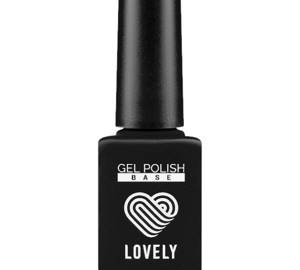
Lovely Nails Photo: Lovely Nails
The rubber base for nails Rubber Base from Lovely Nails has a fairly thick consistency, so even when applied in one layer it evens out all the unevenness and defects of the nail plate, strengthening and protecting against yellowing and pigmentation, and is also very economical in consumption. And if you buy a 50 ml tube, it will definitely last for a long time. Camouflage base: available in nude pale pink, beige and translucent white shades, can be used without a colored layer for a jacket - just apply the base in two layers.
The main advantages of the base: easy to apply, quickly distributed, provides strong adhesion of the gel polish to the nail plate, long-lasting and durable coating without chipping or peeling for up to 3-4 weeks (or even longer if correction was not required due to nail growth) . A convenient wide, tightly packed brush, as well as the absence of a pungent chemical odor, makes application easy and convenient even for a beginner at home.
Advantages and disadvantages
incredible durability of the coating, economical consumption, strengthens the nail plate, suitable for French
bakes strongly in the lamp, can only be removed by sawing it off
show more
UNO LED/UV Rubber Base
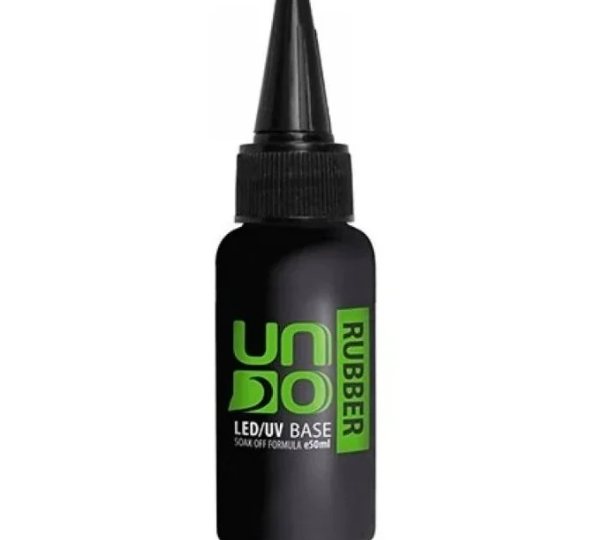
UNO Photo: UNO
Another popular nail base for both professionals and home use is Rubber Base from the UNO brand. A couple of years ago, this base was one of the five most popular products for nail services and has not yet lost its popularity. UNO Base Strong has a medium-thick consistency, is perfectly leveled, does not shrink on long nails and does not bake in a lamp. Due to its dense texture, it is well suited for flexible, soft and brittle nails, strengthening them and smoothing the surface. Thanks to its fairly thick consistency, it does not flow onto the cuticle or onto the side rollers, but is quite easy to apply and distribute. It is worth noting the comfortable elastic brush with an even cut, as well as the fact that the base is easily soaked and removed with gel polish remover. Does not contain formaldehyde or formaldehyde resin, toluene, dibutyl phthalate and camphor, which has a positive effect on the health of the nail plate.
Advantages and disadvantages
safe composition, does not burn in the lamp, suitable for all types of nails
The price is quite high, there is a risk of running into a fake
show more
Why does the coating sags?
Gel polish bases consist of polymer chains that are formed as a result of a polymerization reaction. This process is completely completed only after a few hours or even days. When polymer chains are formed, the molecules come closer together, the distance between them decreases and they take up less space. This is how the material shrinks. Polymer chains have formed, but this is not the end of the polymerization reaction and not the end of the shrinkage of the material. This is clearly visible on the nails 2 weeks after application of the coating. The material begins to sag. This is especially noticeable on the free edge of the nail. The shrinkage causes the tip of the nail to twitch, which visually increases the dip. It is because of the shrinkage of the material that the natural nail curls. The percentage of shrinkage will be different in different materials.
Some people are indifferent to this, but personally I really don’t like it.
I don’t cover my own nails with gel polish, and just like everyone else, I go to a nail technician. I love when nails have a little volume. I had to spend about 8 months to find a master who takes into account the shrinkage of the material when working and correctly selects the base for my nail type.
Finishing fixative
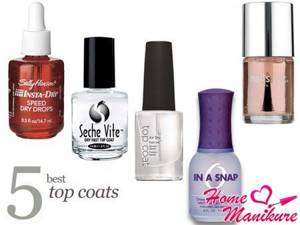
Among women who are accustomed to doing their own manicure exclusively at home, there is sometimes an opinion that a fixative is an optional and even useless thing. Most often, I think so for girls who either never used a topcoat or used regular colorless nail polish as a top coat. In reality, a manicure without a fixative can almost always be easily distinguished from completed nail art. This is explained by a number of positive aspects that accompany the use of a high-quality finishing coating.
- The fixative makes the manicure perfectly finished. A laconic gloss or, on the contrary, a muted matte finish of the nails gives the hands a special charm and grace.
- In addition to aesthetic transformation, the top coat perfectly protects the decorative layer of varnish from external factors, be it chemicals, water or mechanical stress. Thanks to this, the manicure significantly increases its lifespan.
- A nail polish fixer can reduce the time of the entire procedure. Special top-drying accelerates the hardening process of the decorative coating.
How to choose a base for different types of nails
In fact, there are no bad or good bases; there are bases with different physical properties and purposes. It is important to use them correctly. The fact is that each person's nails are unique in their own way. The master’s task is to understand which nails are in front of us and to choose the right base for these very nails.
For example, it is not advisable to apply liquid bases to thin nails, because... They become very hard when cured. As a result, the native nail under the coating may bend or deform, but the hard coating cannot. Therefore, the coating begins to chip and peel off.
On thin nails it is better to apply a rubber-based base. After hardening, such a base can bend slightly along with the natural nail - this will allow you to wear the coating longer.
When the client comes next time, everything is simpler: we see the results of wear and the choice of base becomes obvious. We carefully examine the nail to see if there are any detachments or chips. Where do they start from the cuticle or the end of the nail. The identified problems are like a map that shows us the structural features of these particular nails.
What can you say about the base/top 2in1 product?
You often find offers in online stores (including the aforementioned Salon Service) to sell a bottle of product that is used at the beginning and end of a manicure. What can you say about him? Well, we note the following:
- Ideal for beginners (no confusion about what to apply first);
- Saving money (a 2in1 bottle is cheaper);
- Great if you plan to wear your manicure for a short time, up to 2-3 weeks.
That's all. We hope our article helped you understand the features of base and topcoats, as well as combined products. Don't forget to visit the store we mentioned above. Happy shopping!
Like Like Love Haha Wow Sad Angry
2
Errors when working with the database. What not to do when applying base
- Applying too thin a base layer. It will cause all the irregularities and grooves on the nails to come out. A thin layer will affect the wear of the material. An unstrengthened nail will quickly begin to chip and crack.
- A base layer that is too thick , especially at the ends of the nail, will give unnecessary volume to the nail. And your nails will look like “pies”.
- Insufficient drying time for the base. Drying your nails for less than 15 seconds in an LED lamp is a mistake. The base on top will grab, but not on the inside. And by the way, there is a misconception that you can dry the coating later. There is a standard polymerization time: in a UV lamp 2 minutes in an LED lamp 30/60 seconds, depending on the material.
By the way, I found a very detailed video on this topic on YouTube.
Rubber base In'Garden Ideal Nails
You won’t find the words “rubber” on the bottle; it simply says “leveling.”

I have a large 30 ml jar. I do not recommend using the material directly from such a jar; it is better to pour it into an empty one: if you frequently open and wipe the brush on its edges, the base will accumulate there, the lid will begin to open poorly and bubbles will appear in the base. In addition, the lid itself springs back and tends to slam shut, which is inconvenient to use. This volume is, of course, an economical option, but it is worth considering these subtleties.
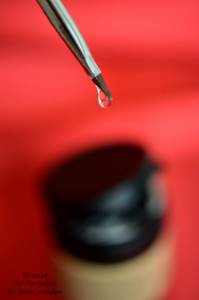
As for the base itself, it is a little thinner than UNO, but it also holds a drop well and is applied thinly. But, again, I couldn’t evaluate her original brush; I used an ordinary flat one.
This is how the base shines after drying in a lamp:
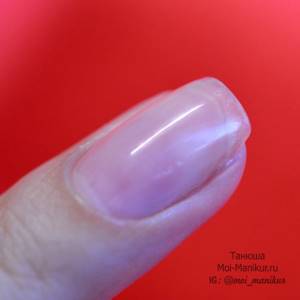
Expensive and cheap base - what are the differences?
Despite the fact that there is nothing natural in both the cheap and expensive bases and there is only chemistry, there is still quality. A cheap base may have a sharp, unpleasant odor, the quality of cleaning of the main components, as a rule, cheap materials are very acidic. Which negatively affects the condition of the nails. An allergy to the material is possible. In expensive bases, there is most often no smell, the materials undergo stricter quality control, there are risks of allergic reactions, but they are minimized.
My rating of bases for gel polishes, and what are my plans for the future
During my career I have tried many base coats. And I decided to make this mini review:
Bluesky
A popular database on AliExpessa. You can also find it in any nail supply store. When I first started getting involved in the nail industry, this base was the first one that fell into my hands. But I’m very glad that I experimented only on myself. I left it for the tips. + Low price - Liquid (some people may like liquid bases, but for me this is the biggest and fattest minus!) - Strong smell - Does not strengthen - Does not even out
Kodi
My second purchase. Perhaps the most popular base among masters. But now there are a lot of fakes for it, plus the base is quite aggressive for nails. + Amazing wear + Thick + Good strengthening + Excellent leveling + Excellent retention of rhinestones + Average price - Has a strong smell - Burns when cured
Supernail by Arnelle
Thick, suitable for a beginner! It sticks to any nails, but can cause small detachments if the nail is very thin and weak. Gives a slight shrinkage. + Thick, you can level it as much as you want and it won’t bleed + Average price + Neutral odor - It bakes during polymerization
My love from Arnelle
Good base, medium consistency, easy to level! For me it's the perfect base for short nails, but also suitable for long nails. Gives a slight shrinkage. + Good wear + Quickly evens out + Has a neutral smell + Average price - On very thin and wet ones, may cause peeling - Stings during polymerization
In fact, all bases bake during polymerization. This is fine. I talked about this in detail in the article why gel polish bakes.
In addition to the brands listed above, I was given several bases to test from new brands that are just entering the market, but for now I have chosen the Arnelle base. I also use their top coat and gel polishes.
I plan to purchase Beautix and Gloss base and top in the future. Fellow craftsmen highly praise these companies
please rate the article, I tried 

( 4 ratings, average: 5.00 out of 5)
By hardness
View this post on Instagram
Post by Gel Polish (@luiphilipp_gel)
Based on the hardness of the coating after polymerization, there are 4 types of bases:
- Hard - Hard, Strong, Extra;
- Medium hardness;
- Brittle or soft;
- Elastic - Rubber, Super, Bio, Flexy, Elastic.
View this post on Instagram
Post by NIKnails Gel Polish (@niknails_gel)
Solid bases, when polymerized, produce a hard, inelastic and immobile coating. Medium and soft ones are slightly less static, that is, they partially retain the mobility of the nail, but are fragile. Elastic form a flexible layer.
How to check what base you have?
- Apply a drop of the product to any dense polyethylene base. A file or piece of film will do. Pull the drop into a long strip of 1-1.5 cm, the thickness of the average coating for leveling;
- Cure in a lamp and remove the stickiness.
When bent, such a test layer will behave differently:
- If it cracks, it is either a brittle or medium base;
- If it bends and bends, it is elastic;
- If it holds its shape tightly and firmly and does not break, it is solid.
View this post on Instagram
Publication from NEONAIL GEL POLISH (@neonail_russia)
Manicurists are recommended to have several different hardness bases in their arsenal in order to select the optimal product for different nails:
- For uneven nail plates, use hard and elastic bases;
- If your nails are thick and short, use a medium base;
- For long nails, a hard base is best. In this case, the elastic one will “walk” in the stress zone, and the medium and soft ones will simply crack;
- If your nails are thin, brittle and damaged, an elastic base is ideal.
There is a small percentage of clients who do not wear foundation well - for them it is necessary to select a base product through experimentation. If elastic doesn't work, try hard. If the hard one also forms defects, additional strengthening with acrylic powder or preliminary application of extension gel may be necessary.

